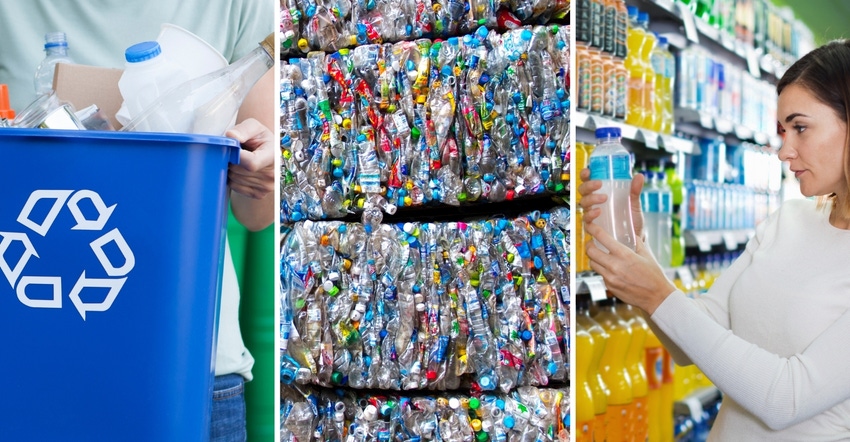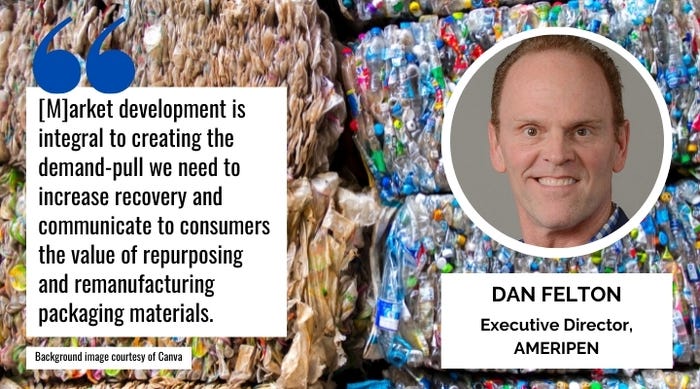Want to Reach Your Packaging Recycling and Recycled Content Goals?
Your success is dependent on how you and others collaborate on this one thing. Do you know what that is?

Recycling market development is having a resurgence. What started in the 1990s as a key strategy by the US Environmental Protection Agency (EPA) to reduce environmental impact via landfill diversion and greenhouse gas reduction, is now is being revisited. Supporting end markets for recycled materials is being looked at as a solution to our dependence on restricted export markets in Asia, expanded interest in recycled content, and increased focus on creating circular economies. Since the state of Washington launched a new recycling development center in 2019, four more states — Colorado, Maryland, New Jersey, and New York — have looked to this model to help advance circularity and create economic growth.
For the past year, AMERIPEN has been working with state market development agencies to understand how industry and states can work together to foster increased packaging recovery. We were surprised to learn that a formal playbook for these programs did not exist, and many program managers were learning through trial and error. Program managers in more established programs were often serving as informal mentors to new programs.
Our new report, produced with Resource Recycling Systems (RRS), “Best Practices for State Recycling Market Development Centers,” explores the approaches used by successful existing organizations and serves as a roadmap for state governments and stakeholders to establish or improve local recycling market development centers.
Getting involved.
Today’s successful programs have used data and the support of stakeholders and government leaders to demonstrate that investments in recycling market development provide positive environmental, economic, and social outcomes to states and local regions. This collaboration is essential to their success.
As more companies set voluntary goals for recycling and use of recycled content, industry expertise is needed to ensure that we have the systems in place to successfully reach those goals. The packaging industry and brand owner companies can and should support building the case for more end-market opportunity in the US. Our findings indicate that programs that have more community engagement — and that can speak to industry demand and barriers to sourcing of post-consumer recycled content — appear to have greater success.
We also learned that recycling market development programs across the US have a variety of objectives. While some programs focus on research and development, others concentrate on attracting businesses to their states or collaborating with local industries to find solutions to use recyclables. Industry insights can strengthen these services to help target needs and highlight their value to government agencies, to other stakeholders, and to the communities they serve.
The same can be said for stakeholders’ expectations of these programs: Collaborative discussions with the industry — including brand owner companies — are necessary to prioritize interests and systematically leverage additional support. In the past, we’ve seen a tendency for state partnerships to redirect concerns toward supply-side issues of municipal collection and contamination. We need industry stakeholders to ensure the primary purpose of new recycling market programs is to create demand for recycled content.
Our work also revealed that more programs are looking to diversify their funding sources to supplement state-allocated money. This includes federal funding and private-sector sources such as grants, sponsorships, and fee-for-service. Here, too, packaging companies and brands can participate — either through direct engagement, commitments to purchase recycled content, or advocacy for more recycling funds to be used for end-market development.
The most effective programs we studied tap into the unique skills of a diverse group of collaborators, namely businesses, state environmental and economic development agencies, and academia, to balance the lifecycle needs of these materials.
Businesses engaged in market development range from those that collect, sort, and process materials to raw materials providers and converters that influence end-of-life options and the brands using the materials to create new products and packaging. Accordingly, those business perspectives should be represented among program staff to better understand the drivers behind a recycling program. Smaller staffs can build external partnerships with industry representatives to gain this crucial expertise.
Facilitating change.
While many factors affect the advancement of packaging recovery, market development is integral to creating the demand-pull we need to increase recovery and communicate to consumers the value of repurposing and remanufacturing packaging materials.

The programs of the 1990s focused mostly on environmental aspects with a minor focus on job creation, but now even the EPA has recognized the incredible economic value recycling also creates for states. Last year, it released its first study on the economic impact of recycling. The report shows that in 2012, “recycling and reuse activities in the US accounted for 681,000 jobs, $37.8 billion in wages, and $5.5 billion in tax revenues.”
As we seek to advance packaging circularity and respond to the increased public attention on plastics, market development will be essential to help our industry advance its goals; our support and engagement in this effort can help our country re-emerge from the COVID-19 pandemic stronger and cleaner.
Please follow AMERIPEN on LinkedIn as we announce more efforts to encourage industry collaboration with these programs as we move into 2022.
About the Author(s)
You May Also Like




